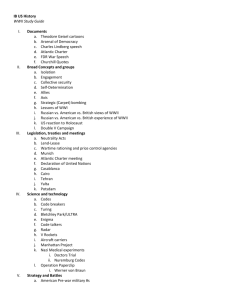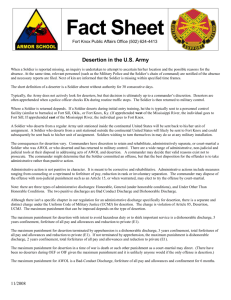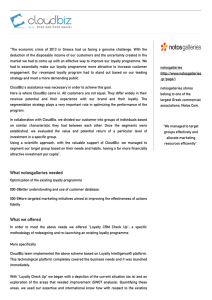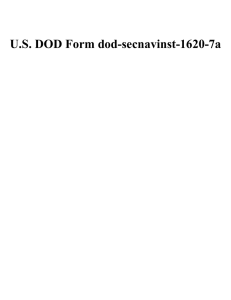Cowards and Heroes: Group Loyalty in the US Civil War
advertisement
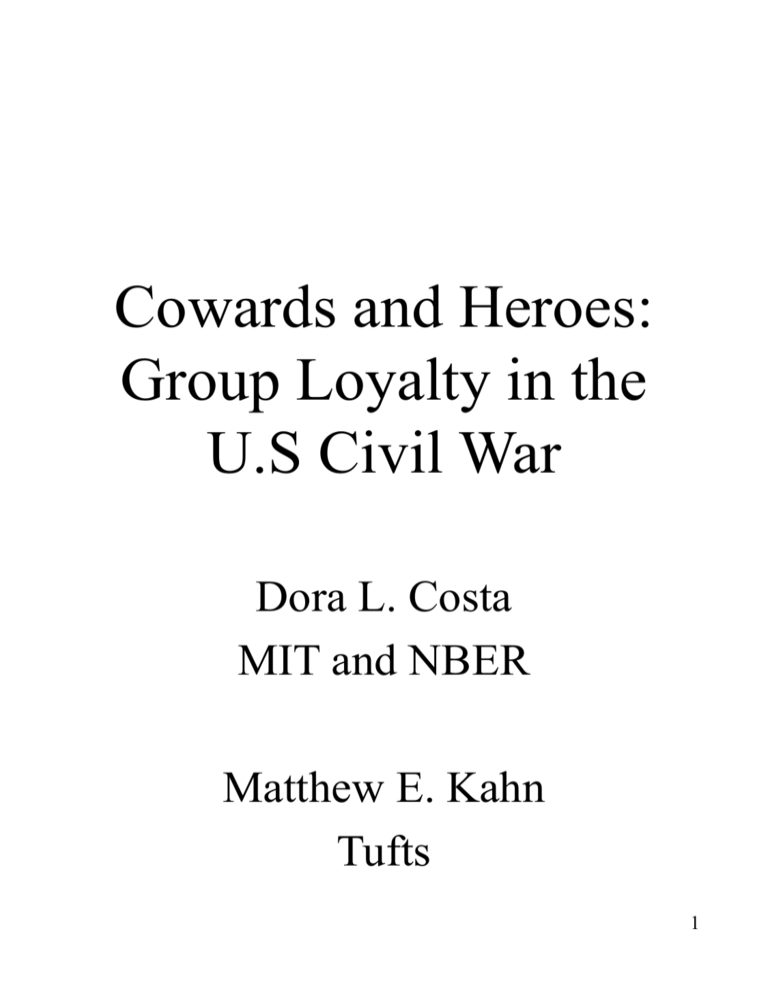
Cowards and Heroes: Group Loyalty in the U.S Civil War Dora L. Costa MIT and NBER Matthew E. Kahn Tufts 1 Introduction • The U.S Civil War was horrific • Soldiers knew that: • Probability of death from disease and battle was high (20%) • Pay was low and irregular • Punishment mechanisms were weak • Why didn’t everyone desert? 2 What motivates soldiers to be loyal to this organization? • Narrow self-interest cannot explain why the desertion rate was only 9% • Alternative Explanations: • Altruism for your fellow men • Desire for their honor and esteem • Ideology • Morale 3 Empirical Contribution • Use a unique data set of 31,850 Civil War Union soldiers to model the propensity to be a “coward” and a “hero” as a function of: • • • • demographics community characteristics ideology morale 4 Cowardly and heroic deeds • Non-market interaction • An important aspect of human behavior that ECONLIT suggests is under-researched 5 The Paper Contributes to Three Growing Literatures • • • • • • Group Loyalty Levitt and Venkatash 2000, Berman 2000, Luttmer 2001, Poterba 1997, Iannaccone 1992 6 Production of Social Capital • Social Capital is the “Glue” that keeps the army united • Growing research on the micro and macro determinants of producing social capital • Alesina and La Ferrara 2000, • Glaeser, Laibson and Sacerdote 2000, • Costa and Kahn 2001 7 Empirical Organizational Design • What types of organizations feature low levels of shirking? • Outcome measures such as turnover levels are higher in more heterogenous divisions based on observables such as age, education, tenure, race and sex (see Pfeffer) 8 Demand and Supply of Military Loyalty • The military faces a tough “agency problem”. • It produces team output – winning battles • The military cannot observe its workers’ effort in the smoke of the battlefield. • The “usual” solutions for agency problems cannot be utilized 9 For the Military: Social Capital can substitute for monetary incentives • If loyalty could be built within the company this would mitigate the agency problems • Such loyalty cannot be “purchased” it must be produced “in-house” 10 How Does Social Capital help this Organization Function? • Self-enforcing peer-pressure, fighting is done in public and your actions are common knowledge among your peers; • Don’t lose face, self-esteem tied to how your peer group views you • More social capital => more group loyalty => less shirking => better chance for victory 11 Will the Men Supply Loyalty? • Survival Instincts says “no” • BUT: If they feel altruism for their fellow men • If they desire the respect of their company • If they believe in the cause • If their side has been winning recently 12 Production Function Framework • Loyalty = f(social capital, individual attributes, morale) • Social capital = g(community attributes) 13 Empirical Design • Hazard model of competing risks (Weibull) • Our Decision Tree • Desertion measures “cowardice” • Promotion measures “heroism” • We examine “cowardice” and “heroism” for men who fought • We do not estimate a war participation equation 14 Robert Fogel’s Union Army Sample • Sample includes 31850 white men who fought for the Union • 303 infantry companies out of 331 randomly sampled and within these companies a 100% sample • their wealth representative of northern population • % all northern men serving ranged from 53 to 81% in 18391845 birth cohorts 15 Company Formation • • • • Company = community How were they formed? local potential for sorting on unobserved skill? • Why do we discount this? 16 Advantages of our Empirical Design • Stakes are high • easy for the researcher to measure “shirking” relative to the modern firm • team members also observe “shirking” • 303 companies provide “crossvariation” 17 Demographic and socioeconomic Determinants Individual Characteristics; • • • • occupation country of birth age and height total personal property wealth in 1860 • Literacy • Marital status 18 Community Determinants • • • • company characteristics -birthplace fragmentation occupation fragmentation age heterogeneity of the company • Do you have a brother in your company? • Population of city enlisted in 19 Ideological Determinants • Volunteer • percent of your county of enlistment who voted for Lincoln • Year mustered 20 Morale Determinants • Momentum variables – share of battles won in the last year • Share of company who died 21 The Geography of Cowardice and Heroism • Table Two • Each column’s entries sum to 100% • Wide variation • Wisconsin and Iowa are special in terms of promotion 22 Summary Statistics • Table Three reports the means of the explanatory variables for; • The whole sample • For “Cowards” • For “Heroes” • Means differ depending on ultimate category 23 We Estimate Separate Hazard Models for Desertion, Arrests, AWOL, and Promotion • We organize our findings by major hypothesis 24 Individual Attributes • • • • • • • The Deserters are: Younger Illiterate Poorer Irish and British Not German Married 25 Community Level Variables • Desertion probabilities are higher in companies where: • heterogeneity is higher as measured by: • birth place, • occupational • age • if you are from a large city • duration dependence parameter 26 in the desertion hazard Community Continued • Unlike the desertion results, the community variables do not intuitively predict promotion to officer (i.e heroism) • Having a brother in your company raises desertion propensity but lowers AWOL propensity • Evidence of Contagion Effect identified due to functional form 27 The “Dark Side” of Social Capital Hypothesis • We find no evidence that in more homogenous communities that the men “collude” to straggle in back • Some evidence of favoritism if the officer and the soldier have similar attributes 28 Ideology • Desertion is Lower for: • Men who enlist early (1861) • Volunteers • Men from Pro-Lincoln counties 29 Morale • Desertion falls when the company death rate is lower • When the Union is winning battles 30 Optimal Organizational Design • Table 8 allows us to show the magnitude of our hazard estimates • If the army wanted to minimize cowardice, Table 8 shows what we predict it could achieve 31 Conclusion • A self-interested soldier would have deserted, yet only a small fraction did. Why didn’t more soldiers desert? • Social capital and fear of loss of honor substituted for incentive pay • The same variables that predict participation in the “modern” social capital literature predict participation in this historical setting 32
